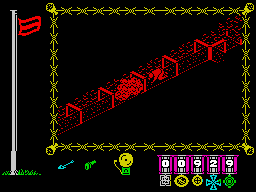
Once assembled, our valiant spaceman had to fuel his craft using a similar method before jetting off. The objective was as compelling as it was simple: parts of Jet Man's rocket descended from above and had to be picked up and dropped in a specific order. Released at a time when many commercial games still contained reams of BASIC code, the smooth and exciting gameplay of Jet Pac elevated it comfortably above its peers, despite being confined to just one screen. While the company was quite rightly renowned for its isometric games, it was with 2D classics such as Sabre Wulf, Tranz Am and this fantastic shooter that Ultimate first made its name. See Also: Horace And The Spiders - Psion (1983) Jet Pac - Ultimate Play The Game (1983) As a pack-in title for many Spectrum bundles, Horace Goes Skiing found its way into the hands of most Spectrum owners, and was a decent, if brief, stab at simulating the sport, not helped by designer William Tang's taste for recklessly-driven ambulances. Appetite presumably satisfied, Horace was ready to take on the piste, although he needed to obtain his equipment first, courtesy of a ski shop that sat rather inconveniently on the opposite side of a busy road.

thing had made its debut a year earlier in the Pac Man clone Hungry Horace. This was the closest the Spectrum got to a bona fide mascot in the vein of Mario or Sonic The Hedgehog, though no-one was ever quite sure what Horace was supposed to be. But using a combination of criteria such as technical achievement, popularity and sheer imagination, I've settled for this dectet of superlative efforts that are surely lodged in the memories of even the most casual Spectrum owner. Picking 10 of them is almost impossible - I could have done 20 or 30. And games, much to the chagrin of Clive Sinclair, were what they got - in their hundreds. No, what the majority of kids wanted from the Spectrum was games. Educational? Game of chess or Scrabble aside, not likely. Programming? Hmm, might try and type in a few POKEs I suppose.


As it turned out, the manufacturer was swimming against the tide. Constantly reiterating its expandability, these initial adverts were all about tech, emphasising the Spectrum's 'massive' RAM of 16 or - crikey! - 48k, as well as its high resolution and accessories, including a printer and the doomed ZX Microdrive. Released 35 years ago this month, the microcomputer was designed by Sir Clive Sinclair with serious applications in mind, and an optimistic role as a central hub for the nation's households. In its early promotional material for the ZX Spectrum, Sinclair often went to almost painful lengths to avoid using the word 'games'.


 0 kommentar(er)
0 kommentar(er)
